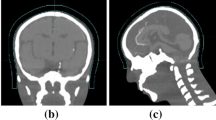Abstract
Intensity-modulated radiation therapy has recently been used for total scalp irradiation. In inverse planning, the treatment planning system increases the fluence of tangential beam near the skin surface to counter the build-up region. Consequently, the dose to the skin surface increases even with small setup errors. Replacing the electron density of the surrounding air of some thickness with a virtual bolus during optimization could suppress the extremely high fluence near the skin. We confirmed the usefulness of a virtual bolus in total scalp irradiation. For each patient, two beams were planned, one with and the other without a virtual bolus. The dose distribution was calculated using computed tomography images that were shifted to simulate setup errors. The hot spot dose was suppressed in the plans using a virtual bolus. In conclusion, using a virtual bolus improved the robustness to setup errors.



Similar content being viewed by others
References
Song JH, Jung JY, Park HW, et al. Dosimetric comparison of three different treatment modalities for total scalp irradiation: the conventional lateral photon-electron technique, helical tomotherapy, and volumetric-modulated arc therapy. J Radiat Res. 2015;56:717–26.
Cuccia F, Figlia V, Palmeri A, et al. Helical Tomotherapy® is a Safe and Feasible Technique for Total Scalp Irradiation. Rare Tumors. 2017;9:6942.
Thomas SJ, Hoole AC. The effect of optimization on surface dose in intensity modulated radiotherapy (IMRT). Phys Med Biol. 2004;49:4919–28.
Moliner G, Izar F, Ferrand R, et al. Virtual bolus for total body irradiation treated with helical tomotherapy. J Appl Clin Med Phys. 2015;16:164–76.
Hadziahmetovic M, Weldon M, Pearson M, et al. Scalp uniform bolus application (SCUBA) technique for homogenous scalp and regional nodal irradiation. Pract Radiat Oncol. 2014;4:e95–e9999.
Author information
Authors and Affiliations
Corresponding author
Ethics declarations
Conflicts of interest
The authors have no conflicts of interest. This is a simulation study using previously acquired information. This study was ethically approved by the institutional review board of the University of Tokyo Hospital, with reference No. 3372.
Additional information
Publisher's Note
Springer Nature remains neutral with regard to jurisdictional claims in published maps and institutional affiliations.
About this article
Cite this article
Takenaka, R., Haga, A., Nawa, K. et al. Improvement of the robustness to set up error by a virtual bolus in total scalp irradiation with Helical TomoTherapy. Radiol Phys Technol 12, 433–437 (2019). https://doi.org/10.1007/s12194-019-00539-1
Received:
Revised:
Accepted:
Published:
Issue Date:
DOI: https://doi.org/10.1007/s12194-019-00539-1




